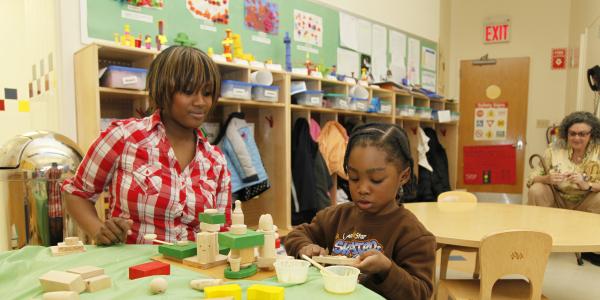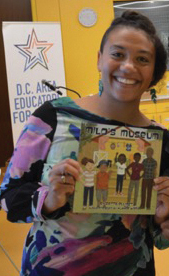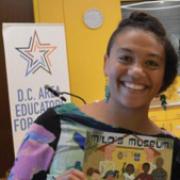From Teacher to Equity Activist

In this edited and adapted excerpt from Each and Every Child: Teaching Preschool with an Equity Lens, activist, scholar, educator, and former Governing Board member Megan Madison reflects on her journey towards activism and offers ideas for other early childhood professionals on how they can become equity and social justice advocates fighting for all young children.
What were your early days in early childhood education like? What was your role? What was your classroom like?
I worked with young children as a babysitter in middle school and then in high school in my church’s nursery school. So as a college student, working as an assistant in a Waldorf elementary school seemed like the perfect part-time job. After I graduated, I moved to Chicago and became a preschool teacher at the Carole Robertson Center for Learning (CRCL) while working on my master’s degree in early childhood education at night.The school was founded with a social justice mission and is firmly rooted in the community. My colleagues taught me that joy and play and community are possible. They taught me that with a little love, roses can grow even from concrete.
Why did you start thinking about social justice issues in early childhood education?
An essay by Charles Bruner talks about the low status and compensation of early childhood educators as a social justice issue. It was like a lightbulb went on! I felt like “Yes, this is the problem! It is so hard for us to do what’s right on behalf of the children and families we love when we are struggling to make ends meet ourselves.” Educators’ well-being is connected. We can’t achieve thriving children, families, and communities on the backs of struggling educators. In the words of Robin Wall Kimmerer, “All flourishing is mutual.”
That was a pivotal moment for me in starting to understand that these social inequities are systemic in nature, that they have to do with policies and practices beyond any one individual. I remember thinking, there was someone, somewhere, at some level of government who decided that I should be paid $40,000 and my coteacher should only make half of that—even though we had the same job description. It didn’t seem fair, and it also didn’t seem like it was in the best interest of children and families.
What did learning about anti-bias education mean to you?
Learning about anti-bias education allowed me to bring together my passion for social justice and my love of early childhood curriculum and pedagogy. Before I heard of anti-bias education, I had never seen examples of activism that involved teachers or young children. I thought that being an activist was something that had to happen outside of school hours, in my free time, and I thought, “Well, that’s never going to happen because as a teacher . . . I have no free time.” Anti-bias education allowed me to see my teaching as activism.
Can you talk about your progression toward thinking of yourself as an activist and advocate for social justice in early childhood education?
At the end of Anti-Bias Education for Young Children and Ourselves, Louise Derman-Sparks and Julie Olsen Edwards (2010) write,
"Anti-bias education work has its own contribution to make, but it is not enough. If we want to see the full vision of anti-bias education come to fruition, then we must work to address a wide range of social and economic justice issues that affect children, their families, and us as their advocates." (159)
This really resonates with me. It’s so clear that if we are to achieve NAEYC’s vision of all children thriving and living in a society dedicated to ensuring they reach their full potential, we need to participate in large social change movements, from Black Lives Matter to Close the Camps to Me Too.
I still wrestle with the titles of activist and advocate, in part because I see the work I do as an integral part of my professional responsibilities as an early childhood educator and my spiritual responsibilities as a human being. The NAEYC Code of Ethical Conduct (2016) states that, “above all, we shall not harm children” (8). We know that white supremacy, the patriarchy, heteronormativity, ableism, settler colonialism, the gender binary, and any other system that inequitably distributes power, resources, and privilege to one group at the expense of another harms children. All children. We therefore have an ethical responsibility to play our part in dismantling these systems.
What are your thoughts for preschool teachers reading this? What are some doable ways preschool teachers can become activists?
Start by finding a trusted friend or colleague to have an honest conversation about what keeps you up at night. Talk to them about what’s in your heart, what your struggles are, and what your passions are. Sometimes talking it out with another person can really help us clarify what we care about and why. Once you have a little bit more clarity, you’ll be ready to find and join a group of other people who care about that same issue.
All social change happens when groups of people organize together to issue a demand in a collective voice.
There’s a big myth out there that change happens when one person, all by herself, stands up for what’s right. Usually when that happens, that one person gets fired. All social change happens when groups of people organize together to issue a demand in a collective voice. The good news is that it isn’t hard to find other changemakers these days. We’re living in a movement moment. If you look, I’m pretty sure you can find your people. They’re out there, waiting for you to bring your unique story, gifts, and energy to the movement.
What do you want early childhood teachers to pay attention to when they look at NAEYC’s position statement on equity?
Pay attention to your feelings as you read through it. What surprises you? Scares you? Excites you? What makes you angry? What makes you sad? The beautiful thing about emotions is that they are all right! There’s no such thing as a wrong feeling. And every emotion is sending us a message about ourselves, where we are, and what we need. Once we know what we need, that can help us figure out our next step.
Do you have any final thoughts you’d like to share?
There is no such thing as neutral or apolitical teaching. Every choice we make in the classroom either reinforces or resists existing systems of privilege, power, and oppression in our society: who we call on during circle time, what read-alouds we choose, how we greet a family member. That reality can feel overwhelming, but I think it can also feel empowering. It means that every single day, we have thousands of opportunities to make our society fairer, safer, more sustainable, and more loving. It means that the work we do really matters.
Whoever is reading this, I hope you know that you are not alone in this work. You are a part of a larger movement of educators, caregivers, and young people all working together to build a world rooted in racial, economic, and social justice. From the bottom of my heart, thank you for the work you do every single day. It really matters.
 Interested in more concrete strategies and tips for implementing NAEYC's position statement on Advancing Equity in Early Childhood Education? Order a copy of Each and Every Child: Teaching Preschool with an Equity Lens from NAEYC's online store!
Interested in more concrete strategies and tips for implementing NAEYC's position statement on Advancing Equity in Early Childhood Education? Order a copy of Each and Every Child: Teaching Preschool with an Equity Lens from NAEYC's online store!
Bruner, C. 2008. “Improving Conditions and Status for Early Childhood Educators.” In Rethinking Early Childhood Education, ed. A. Pelo, 201. Milwaukee, WA: Rethinking Schools.
Derman-Sparks, L. & J.O. Edwards. 2010. Anti-Bias Education for Young Children and Ourselves. Washington, DC: NAEYC.
Megan Pamela Ruth Madison is an early childhood scholar, activist, and practitioner based in New York City. She holds a master’s degree in early childhood education from Dominican University and a bachelor’s in studies in religion from the University of Michigan. Currently, she is pursuing her doctorate at Heller School for Social Policy and Management at Brandeis University. Her research examines the impact of “color blind” policymaking on racial inequities in the field of early childhood education. Megan works part-time as a trainer for the Center for Racial Justice in Education, the Human Root, and the New York Early Childhood Professional Development Institute. In this role, she facilitates workshops for teachers and families on race, gender, and sexuality. She recently completed a term as the first student representative on the NAEYC National Governing Board after several years serving as a cofacilitator of the association’s Diversity and Equity Interest Forum. Megan also serves on the Board of Directors for Jews for Racial and Economic Justice.
